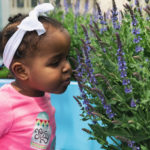‘Our silver lining’: Mila is thriving after CDH repair

For Katie, last St. Patrick’s Day wasn’t an occasion for revelry. Instead, it was the day an ultrasound revealed that their daughter, Mila, would be born with a congenital diaphragmatic hernia (CDH). In this condition, the diaphragm — the layer of muscle and tissue between the chest and abdominal cavity — forms with a hole in it. This can lead to severe lung problems and other concerns.
Katie, whose youngest son had undergone a liver transplant several years earlier, is no stranger to hospitals or health care. But knowing that Mila might not survive “felt very personal,” she says. “It was a terrible, dreary feeling that took over my whole pregnancy. We called off any celebrations. I closed the door to her nursery and didn’t go back in.”
Finding the right team
But Katie also knew they would do whatever it took to give Mila a chance. Through her research, she learned about the Congenital Diaphragmatic Hernia Program at Boston Children’s Hospital, and read stories of babies with CDH who were now thriving. “I liked that Boston Children’s has a complete clinic of experts caring for kids with CDH, instead of just one surgeon,” she explains. “It was a breath of fresh air.”
Before Mila was even born, Katie met the program’s directors, Drs. Jill Zalieckas and Belinda Dickie, as well as Olivia Oppel, a registered nurse in the Maternal Fetal Care Center. “They gave us confidence, calmed us, and helped us feel like we were part of the team,” says Katie. “As hard and as scary as it was, we knew we were in the right place.”

Support during a hard time
Following Mila’s birth, she underwent CDH repair surgery with Dr. Dickie, spending some 11 weeks in the medical intensive care unit and then more time in the hospital to gain strength. It wasn’t easy: The time was filled with ups and downs for Mila, ranging from feeding to difficulty withdrawing from the drug used to sedate her to an intestinal malrotation. Through it all, Lindsay Lemire, the program’s nurse practitioner, was by her side — and Katie’s.
“Lindsay acknowledged our fears but also gave us the confidence we needed to get through it,” says Katie. “I didn’t have to explain what I was feeling — she just gets it, as a nurse, a mom, and a human being.” On the hardest days, she simply provided a shoulder to cry on. “Lindsay helped carry me through this,” says Katie. “And that support helped me be able to support Mila.”

A new beginning
After nearly three months in the hospital, Mila was finally able to come home. Today, Mila is “feisty” — a characteristic Katie attributes to all the time her daughter spent fighting for her life. A happy, curious baby who’s meeting all her milestones, she loves bananas and is starting to learn how to wave goodbye. Once averse to even using a pacifier, she can now nurse, take a bottle, and even drink from a cup. “You’d never know what she went through,” says Katie. “That she’s doing so well now — that’s our silver lining.”
Like other kids born with CDH, she’ll continue seeing the CDH team for follow-up visits — and, like other parents, Katie knows she’ll need to do some healing, too, from the trauma she endured. For now, she’s focusing on the positive. “At her first outpatient appointment, Lindsay told me, ‘Mila looks great, and you look so happy too,’” remembers Katie. “And I am.”
Learn more about the Congenital Diaphragmatic Hernia Program.
Related Posts :
-

From Cape Verde for coordinated CDH care
Most parents have never heard of congenital diaphragmatic hernia (CDH), a rare and potentially life-threatening condition in which a baby ...
-

Making it through the fight: Scarlett's CDH journey
Like her name suggests, Scarlett Virginia Moulton “has a lot of fire,” says her mother, Olivia. “She always has a ...
-

Incredible Teddy: Thriving with CDH
Andi Lodico left for the hospital at 1 a.m., in labor with her second child. She didn’t return home ...
-

Alivia’s journey with CDH
Alivia Gannon recently got the kind of information every kid wants to hear: She won’t have to return to ...





